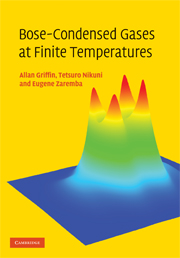Book contents
- Frontmatter
- Contents
- Preface
- 1 Overview and introduction
- 2 Condensate dynamics at T = 0
- 3 Coupled equations for the condensate and thermal cloud
- 4 Green's functions and self-energy approximations
- 5 The Beliaev and the time-dependent HFB approximations
- 6 Kadanoff–Baym derivation of the ZNG equations
- 7 Kinetic equation for Bogoliubov thermal excitations
- 8 Static thermal cloud approximation
- 9 Vortices and vortex lattices at finite temperatures
- 10 Dynamics at finite temperatures using the moment method
- 11 Numerical simulation of the ZNG equations
- 12 Simulation of collective modes at finite temperature
- 13 Landau damping in trapped Bose-condensed gases
- 14 Landau's theory of superfluidity
- 15 Two-fluid hydrodynamics in a dilute Bose gas
- 16 Variational formulation of the Landau two-fluid equations
- 17 The Landau–Khalatnikov two-fluid equations
- 18 Transport coefficients and relaxation times
- 19 General theory of damping of hydrodynamic modes
- Appendix A Monte Carlo calculation of collision rates
- Appendix B Evaluation of transport coefficients: technical details
- Appendix C Frequency-dependent transport coefficients
- Appendix D Derivation of hydrodynamic damping formula
- References
- Index
14 - Landau's theory of superfluidity
Published online by Cambridge University Press: 06 October 2009
- Frontmatter
- Contents
- Preface
- 1 Overview and introduction
- 2 Condensate dynamics at T = 0
- 3 Coupled equations for the condensate and thermal cloud
- 4 Green's functions and self-energy approximations
- 5 The Beliaev and the time-dependent HFB approximations
- 6 Kadanoff–Baym derivation of the ZNG equations
- 7 Kinetic equation for Bogoliubov thermal excitations
- 8 Static thermal cloud approximation
- 9 Vortices and vortex lattices at finite temperatures
- 10 Dynamics at finite temperatures using the moment method
- 11 Numerical simulation of the ZNG equations
- 12 Simulation of collective modes at finite temperature
- 13 Landau damping in trapped Bose-condensed gases
- 14 Landau's theory of superfluidity
- 15 Two-fluid hydrodynamics in a dilute Bose gas
- 16 Variational formulation of the Landau two-fluid equations
- 17 The Landau–Khalatnikov two-fluid equations
- 18 Transport coefficients and relaxation times
- 19 General theory of damping of hydrodynamic modes
- Appendix A Monte Carlo calculation of collision rates
- Appendix B Evaluation of transport coefficients: technical details
- Appendix C Frequency-dependent transport coefficients
- Appendix D Derivation of hydrodynamic damping formula
- References
- Index
Summary
In this chapter, we review the famous Landau theory of superfluidity at finite temperatures. This theory is based on coupled hydrodynamic equations for the superfluid and normal fluid components. Landau's two-fluid description is only valid when collisions among the thermal excitations making up the normal fluid are strong enough to produce local hydrodynamic equilibrium. These two-fluid equations were originally developed for liquid. He but are thought to be generic in form, describing the collision-dominated hydrodynamic region of all Bose superfluids. In this chapter, we will consider the solutions of the two-fluid equations mainly for a uniform superfluid. We discuss the existence of second sound (involving the out-of-phase motion of the superfluid and normal fluid components) as a characteristic feature of a Bose superfluid at finite temperatures.
This chapter gives background material needed for Chapters 15–19. In Chapter 15, we will show that, in the appropriate limit, the Landau two-fluid equations can be derived from the ZNG coupled equations given in Chapter 3 for a trapped dilute Bose-condensed gas. In Chapters 17–19, we extend this discussion and derive the Landau–Khalatnikov two-fluid equations, which include hydrodynamic damping associated with various transport coefficients. Useful reviews of the two-fluid equations in the context of dilute spatially uniform Bose-condensed gases are given by Pethick and Smith (2008, Chapter 10) and Pitaevskii and Stringari (2003, Chapter 6).
History of two-fluid equations
The original discovery of superfluidity in liquid He was dramatically announced with the publication of the famous back-to-back papers of Kapitza (1938) in Moscow and Allen and Misener (1938) in Cambridge. These and subsequent experiments in the next few years showed that superfluid He could exhibit very bizarre hydrodynamic behaviour compared to classical liquids.
- Type
- Chapter
- Information
- Bose-Condensed Gases at Finite Temperatures , pp. 309 - 321Publisher: Cambridge University PressPrint publication year: 2009



